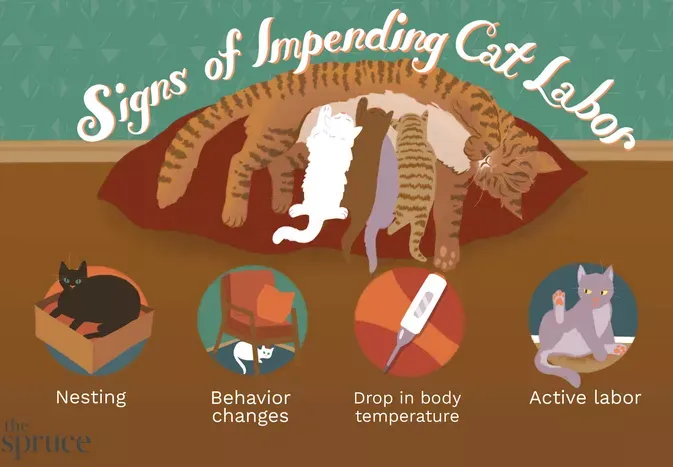How to Help a Pregnant Cat Give Birth
Updated on 04/26/24

Headline: Guide to Assisting Your Pregnant Cat's Labor: A Comprehensive Guide
Introduction:
Congratulations on your furry friend's impending motherhood! Assisting a feline during childbirth is a rewarding and essential task that requires preparation and knowledge. In this comprehensive guide, we will delve into the signs of approaching labor, the necessary steps for preparing your feline companion, and the step-by-step process of assisting her through the birth of her kittens.
Signs of Approaching Labor:
* Nest-building: Your cat may start seeking secluded areas and gathering materials to create a comfortable nesting spot.
* Appetite changes: A decrease in appetite and a selective interest in certain foods are common.
* Behavioral changes: Your cat may become restless, affectionate, or withdrawn.
* Physical changes: Her mammary glands will become enlarged and produce milk. Her belly will also drop as the kittens descend into the birth canal.
Preparing Your Cat for Labor:
* Create a safe and comfortable nesting area: Provide a secluded box or basket with soft bedding and a warm heating pad.
* Gather essential supplies: Have clean towels, sterile gloves, a thermometer, and scissors on hand for possible assistance.
* Restrict access to food: Withhold food within a few hours of labor to avoid complications during birth.
* Monitor your cat closely: Keep an eye on her behavior and physical signs to anticipate the onset of labor.
Step-by-Step Guide to Assisting a Pregnant Cat Give Birth:
Step 1: Provide a Supportive Environment
* Establish a calm and quiet atmosphere in the chosen nesting area.
* Reassure your cat with gentle strokes and a soothing voice.
* Assist her in assuming a comfortable position, either lying on her side or squatting.
Step 2: Monitor Labor Progress
* Take your cat's temperature rectally every 2 hours to track progress. A temperature drop below 99°F (37.2°C) indicates impending birth.
* Observe for signs of discomfort or distress, such as excessive straining or crying.
Step 3: Assist with the Birthing Process
* First stage: As the kitten enters the birth canal, you may see a clear sac filled with fluid. If the mother does not rupture the sac within a few minutes, gently tear a small hole to assist the kitten's breathing.
* Second stage: The kitten's head will appear first. Gently guide the kitten's head out by applying gentle downward pressure on its forehead.
* Third stage: The kitten's body will follow the head. Support the kitten as it fully exits the birth canal.
Step 4: Post-Birth Care
* Break the umbilical cord: Use sterile scissors to cut the umbilical cord about an inch from the kitten's belly.
* Remove the placenta: The mother cat will typically eat the placenta. If she does not, gently remove it and dispose of it.
* Stimulate the kitten: Use a clean towel to gently rub the kitten's body to stimulate breathing.
* Place the kitten with its mother: Once the kitten is stable, return it to the nesting area with the mother for nursing.
Complications and When to Seek Veterinary Assistance:
* Prolonged labor: If labor lasts for more than 24 hours, seek veterinary assistance immediately.
* Difficulty delivering: If the mother cat is unable to deliver a kitten after several hours of straining, professional help is needed.
* Abnormal discharge: Green or foul-smelling discharge during labor may indicate an infection.
* Kitten in distress: If a kitten is not breathing or appears weak, seek veterinary attention as soon as possible.
Additional Tips:
* *Remain calm throughout the process.*
* *Do not interfere unless necessary.*
* *Keep the nesting area clean and warm.*
* *Provide ample fresh water for the mother cat.*
* *Monitor the mother cat and kittens for any signs of complications.*
Assisting a pregnant cat give birth can be a fulfilling experience. By following these guidelines and seeking veterinary assistance when necessary, you can ensure a safe and successful delivery for your feline friend and her precious kittens.
Explore More Pets

Cat Behavior Problems
How to Stop Aggression in Kittens

Long-Haired Cat Breeds
Siberian Cat: Breed Profile, Characteristics, & Care

Cat Behavior Problems
How to Stop Kittens From Scratching and Biting

Long-Haired Cat Breeds
Turkish Angora: Cat Breed Profile, Characteristics & Care

Basic Training
How to Socialize Your Kitten

Short-Haired Cat Breeds
Cute Pictures & Facts About Calico Cats & Kittens

Litter Box Training
Training Your Kitten to Use the Litter Box

Long-Haired Cat Breeds
10 Fun Facts About White Cats